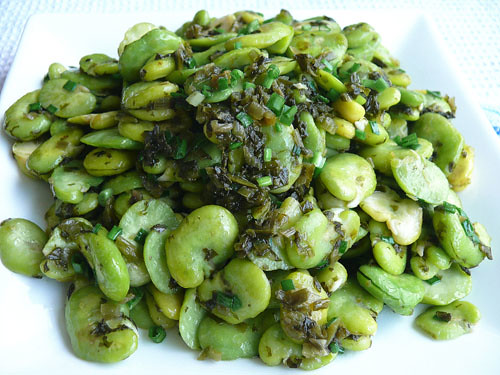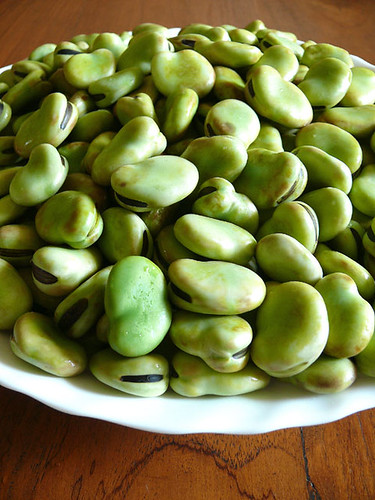
Stir-fried fava beans with xuecai. The beans can be mashed too; Wey likes them like that.

In Shanghainese, these shelled fava beans are called douban. Before shelling, the douban are in pods and are called swee dou. Each pod is about 4-5 times the size of a french bean. Malaysia's petai pod is flat, but more than thrice as big and long as the fava bean pod.

The shelled fava beans have a second shell which has to be removed for frying.
MIL sent 4 kgs of fava beans (broad beans in Britain and ex-colonies, but since I'm more pro-American than Brit, I'll call them fava beans) to my house yesterday. The beans were brought in by my high-flying SIL who was recently in Shanghai.
I have never eaten fresh fava beans. What we get here, usually in cinemas, are deep fried salted fava beans still in their inner shells. In my travels, I've seen fava beans and longed to try them but since cooking is not an option in hotels, I've never had the chance to eat this spring veg.
So I looked at the fava beans and had no idea what to do with them. I gave some to my sis who also didn't know what to do with them (I think she'll just boil them). I remember a copy of Saveur which featured fava beans, but I couldn't find the magazine after a frantic search (my beans were oxidizing quickly). I did find a recipe for the Egyptian national dish called ful mademes, but the beans have to be dried. Other western ways of cooking fava beans were to use the boiled beans in salads, usually with some mint. So, back to MIL and her Shanghainese way of cooking sweedou. Doubanjiang, the hot bean paste used in Sichuan cooking, is made with these beans. I always thought the paste was made from soy beans.
My conclusion after tasting fresh fava beans is that you really don't need to be fussy about cooking them. I used chicken stock when I fried the douban, but because the beans were naturally slightly sweet the result was a little too savory-sweet, so for the recipe below I used some water in addition to the stock. The Shanghainese way of sauteing the beans with a little bit of oil, salt, sugar and either spring onions or xuecai (a Shanghainese preserved veg) gives a simple yet delicate plate of beans that can be eaten as a snack or as a dish with rice. This is also how fresh soy beans (mao dou) are usually cooked in Shanghai, with the addition of bean curd sheets called ba yeh. I am drooling already. High time to visit Shanghai, H1N1 or not.
How do fava beans taste? The texture is somewhat like regular peas, very tender-nutty, and the taste is slightly sweet with a flavor of...fava beans. Wey said they remind him of petai, only fava beans are softer and without a strong flavor.
Stir Fried Douban, Fava Beans
400 g fresh fava beans, shelled
1/3 cup xue cai*, washed & chopped finely
1 T chopped spring onions
veg oil, a pinch of salt and sugar
about 2 T water & 2 T chicken stock
*this is a common ingredient used in Shanghainese cooking. You can get it in small cans in some Chinese grocers'. You can omit it but the resulting dish won't be as well-flavored.
1. Put about 2 T veg oil in a heated wok or pan, add the beans and stir fry at medium high heat for a couple of seconds. Add the xuecai, a pinch of salt (remember the xuecai is salted) and sugar. Add 1 T water or stock, stir fry until water is gone, then repeat until you have added about 4 T of water and stock. This dish should not be watery. This is dry frying so make sure the water or stock has evaporated between each addition of water/stock. All in, it takes about 4-5 minutes. You can put a lid over for 20 sec or so a couple of times. The beans should be quite soft.
2. Throw in the spring onions, stir to mix (if you like the beans mashed, use your ladle and cut them, pressing lightly to mash them) and dish out.

In Shanghainese, these shelled fava beans are called douban. Before shelling, the douban are in pods and are called swee dou. Each pod is about 4-5 times the size of a french bean. Malaysia's petai pod is flat, but more than thrice as big and long as the fava bean pod.

The shelled fava beans have a second shell which has to be removed for frying.
MIL sent 4 kgs of fava beans (broad beans in Britain and ex-colonies, but since I'm more pro-American than Brit, I'll call them fava beans) to my house yesterday. The beans were brought in by my high-flying SIL who was recently in Shanghai.
I have never eaten fresh fava beans. What we get here, usually in cinemas, are deep fried salted fava beans still in their inner shells. In my travels, I've seen fava beans and longed to try them but since cooking is not an option in hotels, I've never had the chance to eat this spring veg.
So I looked at the fava beans and had no idea what to do with them. I gave some to my sis who also didn't know what to do with them (I think she'll just boil them). I remember a copy of Saveur which featured fava beans, but I couldn't find the magazine after a frantic search (my beans were oxidizing quickly). I did find a recipe for the Egyptian national dish called ful mademes, but the beans have to be dried. Other western ways of cooking fava beans were to use the boiled beans in salads, usually with some mint. So, back to MIL and her Shanghainese way of cooking sweedou. Doubanjiang, the hot bean paste used in Sichuan cooking, is made with these beans. I always thought the paste was made from soy beans.
My conclusion after tasting fresh fava beans is that you really don't need to be fussy about cooking them. I used chicken stock when I fried the douban, but because the beans were naturally slightly sweet the result was a little too savory-sweet, so for the recipe below I used some water in addition to the stock. The Shanghainese way of sauteing the beans with a little bit of oil, salt, sugar and either spring onions or xuecai (a Shanghainese preserved veg) gives a simple yet delicate plate of beans that can be eaten as a snack or as a dish with rice. This is also how fresh soy beans (mao dou) are usually cooked in Shanghai, with the addition of bean curd sheets called ba yeh. I am drooling already. High time to visit Shanghai, H1N1 or not.
How do fava beans taste? The texture is somewhat like regular peas, very tender-nutty, and the taste is slightly sweet with a flavor of...fava beans. Wey said they remind him of petai, only fava beans are softer and without a strong flavor.
Stir Fried Douban, Fava Beans
400 g fresh fava beans, shelled
1/3 cup xue cai*, washed & chopped finely
1 T chopped spring onions
veg oil, a pinch of salt and sugar
about 2 T water & 2 T chicken stock
*this is a common ingredient used in Shanghainese cooking. You can get it in small cans in some Chinese grocers'. You can omit it but the resulting dish won't be as well-flavored.
1. Put about 2 T veg oil in a heated wok or pan, add the beans and stir fry at medium high heat for a couple of seconds. Add the xuecai, a pinch of salt (remember the xuecai is salted) and sugar. Add 1 T water or stock, stir fry until water is gone, then repeat until you have added about 4 T of water and stock. This dish should not be watery. This is dry frying so make sure the water or stock has evaporated between each addition of water/stock. All in, it takes about 4-5 minutes. You can put a lid over for 20 sec or so a couple of times. The beans should be quite soft.
2. Throw in the spring onions, stir to mix (if you like the beans mashed, use your ladle and cut them, pressing lightly to mash them) and dish out.

4 comments:
ohhhh tat sounds like yum..
dont think i ever had these b4..
this is shanghaines favorite...
joe:u will one day :)
anon: i bet u r shanghainese. in fact i think i know who u r.lol.
Post a Comment